Procloëon bifidum - Pale Evening mayfly
Phylum: Arthropoda - Class: Insecta - Order: Ephemeroptera - Family: Baetidae
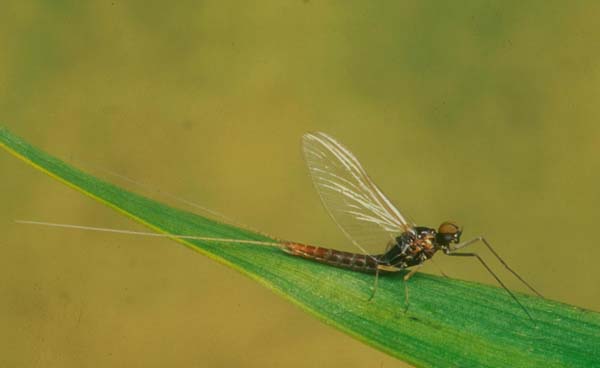
Procloeon bifidum imago male - Pale Evening Spinner (m)
Note: strictly the genus name is Procloëon, but as people searching for information on the internet do not generally include accents (diacritical marks) such as the umlaut above the character ë, we have used the easier-to-type Procloeon in the main text of this page.
This upwinged fly is readily distinguished from other river mayflies by the absence of any hindwings.
Distribution
The Pale Evening mayfly is fairly common and widespread in Britain and Ireland, where it occurs on most kinds of flowing water including chalkstreams, limestone rivers and neutral to moderately acidic spate rivers.
Nymph
The nymph of Procloeon bifidum, the Pale Evening mayfly, is one of the agile darters, but it has a preference for gentle glides and pool margins rather than rapid water. In the evening, when the sub-imago (dun) is ready to emerge, the nymph swims up to the surface..
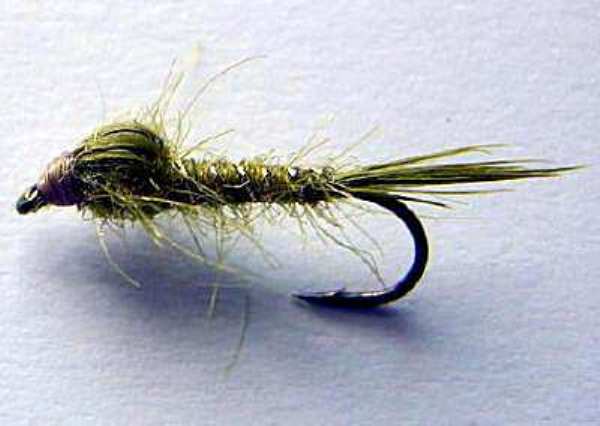
An artificial Olive Nymph
Any slim-bodied olive-coloured artificial nymph fished in the surface film seems to work well when Pale Evening Duns are hatching. When there is no hatch a weighted nymph such as a bead-headed Gold-ribbed Hare's Ear is likely to be necessary to get down to where the trout are feeding.
As always when flyfishing on food-rich waters, matching the hatch can make a big difference, but it's not merely a matter of making your fly the right size, colour and shape so that it looks like the insect you are trying to imitate. Most important of all, you need to make your fly behave like the natural insect. This is a subject I cover in detail in Matching the Hatch, and in my experience behaviour is the most important topic in flyfishing. Put simply, to be a really good flyfisher you need to know how aquatic insects behave, how trout behave, and how you need to behave in order to make your fly behave like a credible insect... and without scaring the fish!
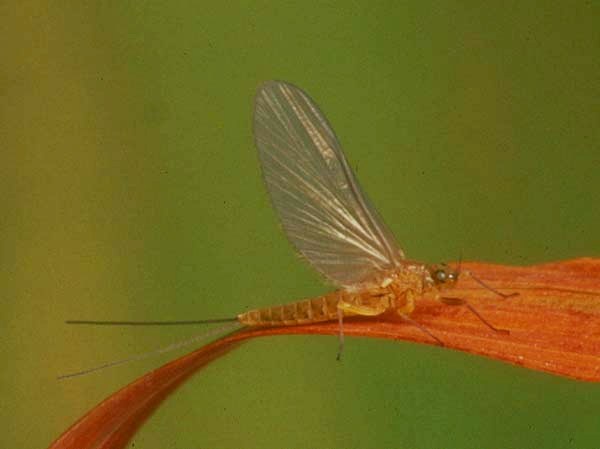
A female Pale Evening Dun
Dun or subimago
The Pale Evening Dun emerges between May and October, but the densest hatches are usually on summer evenings.
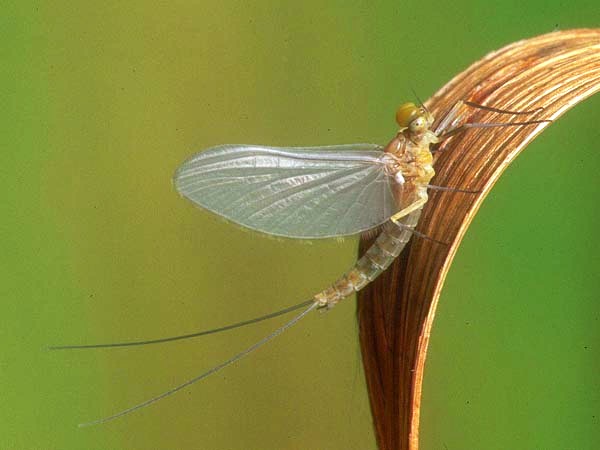
A male Pale Evening Dun
A good general imitation for all sorts of olive duns including the Pale Evening dun is that old favourite, Greenwell's Glory. A Rough Olive can be equally effective, I find.
Of course, a lot depends on how windy the weather is, because without a surface riffle the fishing can be very tough indeed, especially on bright summer days. That is when a closer imitation of the Pale Evening dun really can be all the difference between success and failure.
You won't need to differentiate between male and female duns when choosing an artificial fly to match the hatch when Pale Evening mayflies are about in good numbers, but if you would like to be able to tell males from females it's very easy: just look them straight in the eye.
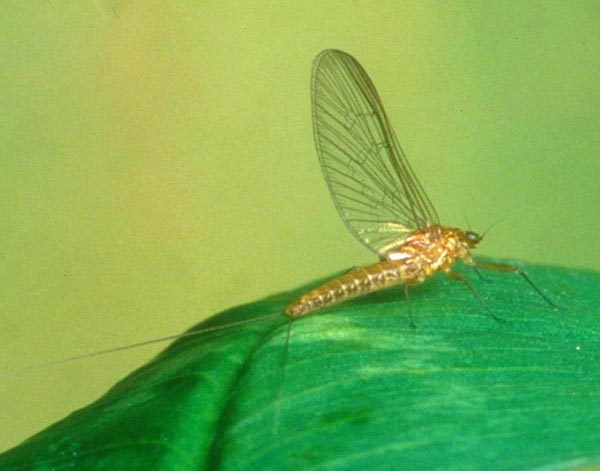
A female Pale Evening spinner
Male duns and spinners of the Pale Evening mayfly, in common with several other closely related up-winged flies, have what are termed 'turbinate' (turban-shaped) eyes. Having these specially adapted eyes is thought to help male (at the spinner stage, actually) to locate females that are not yet paired with another male in a swarm. It seems to work, because these and other related mayfies seem to be suffering less than many from the many pressures affecting riverfly populations in Britain and Ireland.
Incidentally, the only other largish British up-winged flies other than Procloeon bifidum, the Pale Evening mayfly, that have no hindwings occur on stillwaters; they are the Pond Olive Cloeon dipterum and the Lake Olive Cloeon simile.
Flyfishing Tip
A Tups Indispensable is a pretty good representation of the egg-laying spinner, and a size 14 is about right to match the size of the natural insect. Spent spinners, on the other hand, deserve a closer imitation, because trout have more time to inspect them. A spent-wing tying style is much better than a hackled fly.
In my book Matching the Hatch, which I wrote for flyfishers of all abilities, there is plenty for experienced anglers as well as newcomers to the sport. There you will find large pictures and tying details for some superb patterns (a few are my own but most have been contributed by the world's top flyfishers including Charles Jardine, Brian Clarke, Bernard Venables, Jon Beer and many others. There are some very good matches for both duns and spinners, artificial flies that have been proven to give great results, especially on days when the fishing is tough. It is all written in jargon-free plain language that won't give a beginner a headache.
Excited by rivers and streams? So are we, and we're pretty sure you would find the Winding River Mystery trilogy of action-packed thrillers gripping reading too. Dead Drift, Dead Cert, and Dead End are Pat O'Reilly's latest river-based novels, and now they are available in ebook format. Full details on our website here...
Buy each volume in ebook format for only £2.47 on Amazon... Paperbacks also available on Amazon at £6.95 each. All proceeds go towards keeping the First Nature website online.
Please Help Us: If you have found this information interesting and useful, please consider helping to keep First Nature online by making a small donation towards the web hosting and internet costs.
Any donations over and above the essential running costs will help support the conservation work of Plantlife, the Rivers Trust and charitable botanic gardens - as do author royalties and publisher proceeds from books by Pat and Sue.
